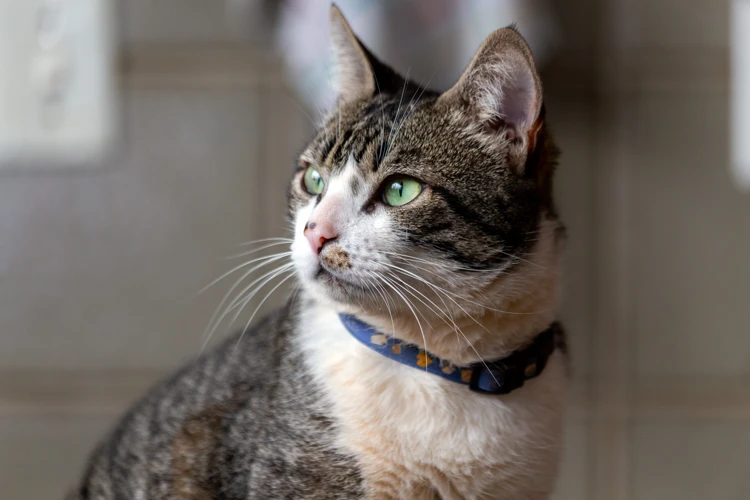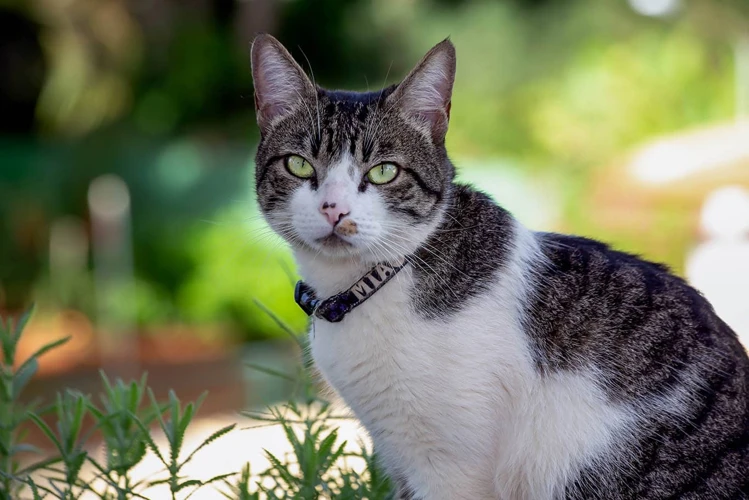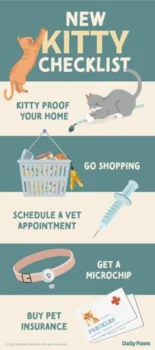Welcoming a wirehair kitten into your home can be a joyous and exciting experience. However, it also requires careful planning and preparation to ensure your new feline friend is happy, healthy, and safe. From pet-proofing your living space to setting up essential supplies, and socializing and taking care of your kitten’s health, there are many steps to take before bringing your furry friend home. In this article, we’ll share tips and tricks for preparing your home for wirehair kittens, so you can give your new pet the best start to a long and happy life together.
Pet-Proofing

Protecting your home from potential hazards and dangers is a crucial step in preparing for your new wirehair kittens. Ensuring their safety requires pet-proofing your space, removing hazardous materials, and providing a suitable environment for them to thrive in. Before bringing your new furry friends home, consider implementing these essential tips to create a safe and secure environment for your wirehair kittens. For more information on wirehair kitten care, check out our article on understanding wirehair kitten stages.
Secure Your Home Space
When preparing your home for Wirehair kittens, it’s crucial to make sure that your space is safe and secure for them to explore. Wirehair kittens are playful and curious by nature and can get into trouble if they come across hazards in your home. Here are some tips on how to secure your home space:
| Tip | Description |
|---|---|
| Secure loose wires and cords | Loose wires and cords can be a choking hazard for your kittens, and they may also be tempted to chew on them. Use cord covers or tape to secure wires and cords against baseboards or walls. |
| Store chemicals and cleaning supplies | Keep chemicals and toxic cleaning supplies (such as bleach, detergents, or pesticides) out of reach of your kittens. Consider using childproof locks or storing them in a high cabinet. |
| Block off tight spaces | Wirehair kittens are small and can easily crawl into tight spaces, such as behind appliances or under furniture. Block off these areas or cover them with sturdy mesh or tape. |
| Keep breakable items out of reach | Keep fragile or valuable items out of reach of your kittens. This includes decor, kitchenware, and electronics as they can be easily knocked over or damaged by your kitten’s playful and exuberant behavior. |
| Install screens on windows and balconies | Wirehair kittens are curious by nature and may try to jump or climb out of open windows or balconies. Install screens on all windows and balconies to prevent accidents. |
| Check for small items | Check your home for small items that could be choking hazards for your kitten(s). This includes things like small toys, coins, rubber bands, and buttons. |
By taking these precautions, you can ensure that your kittens will have a safe and secure place to live and explore, which is the key for their healthy development. In the next sections of our article, we will cover other aspects of caring for your wirehair kittens like feeding and sleeping arrangements. You can also have a look at our guide to wirehair litter health to make sure your Wirehairs are provided with everything they need.
Remove Hazardous Materials
When preparing your home for wirehair kittens, it’s crucial to remove any hazardous materials that could harm your furry friends. Your pet’s safety should be your top priority.
Common Hazardous Materials:
| Material | Effects on Kittens | Alternative Solutions |
|---|---|---|
| Houseplants (such as lilies, tulips, and azaleas) |
Can cause vomiting, diarrhea, and even kidney failure in extreme cases. | Opt for pet-friendly plants like spider plants, ferns, and bamboo. |
| Human Medications (such as painkillers and antidepressants) |
Can be toxic or fatal to kittens, even in small doses. | Store medications in a secured cabinet or drawer that kittens can’t access. Dispose of expired medications properly. |
| Cleaning Products (such as bleach, ammonia, and disinfectants) |
Can cause irritation, respiratory problems, and even chemical burns. | Use pet-friendly cleaning products, or keep hazardous cleaners in a secure cabinet or high shelf out of reach of your kittens. |
| Electrical Wires and Cords | Chewing on electrical wires and cords can cause electrocution or burns and can also lead to fires. | Secure cords and wires behind furniture or in cord protectors. Use deterrent sprays or cover cords in bitter apple spray to prevent kittens from chewing on them. |
Be sure to always check your home for any other hazardous materials or potential dangers. Any small or sharp objects should be stored away or kept out of reach. Keep toilet lids closed to prevent drowning accidents.
By removing hazardous materials in your home, you’re ensuring your wirehair kittens will stay safe and healthy. For more tips on wirehair kitten care, check out our article on newborn wirehair care tips.
Sleeping and Feeding Areas

When preparing your home for a new wirehair kitten, it’s important to consider their sleeping and feeding areas. Providing a comfortable and secure space for your kitten to rest and eat can help them feel safe in their new environment. Let’s take a look at some tips for choosing the right bed and setting up a feeding station for your new furry friend. To ensure that your kitten grows up healthy and happy, we also recommend checking out our articles on newborn wirehair health and feeding tips.
Choosing a Bed
When choosing a bed for your wirehair kittens, there are several important factors to consider. The bed should be comfortable, safe, and easy to clean. You also want to choose a bed that will fit your kitten’s needs as they grow.
Size: The bed should be large enough to accommodate your growing kitten. If you have multiple kittens, make sure the bed is big enough for both of them.
Material: Look for beds made of durable, non-toxic materials such as cotton, fleece, or polyester. Avoid beds with loose stuffing that can be harmful if your kitten ingests it.
Shape: There are many different shapes of beds available such as round, oval, and square. Choose a bed that matches your kitten’s sleeping habits. Do they like to curl up or stretch out? This will determine which shape is the best for them.
Location: Decide where you want the bed to be located and measure the space. You should consider that your wirehair kittens’ bed should be in a quiet and safe area of your home where they can sleep comfortably.
Price: Beds can range from inexpensive to costly. Consider your budget when choosing a bed. It is possible to find a comfortable and safe bed for a reasonable price.
By taking the time to choose the right bed, you are ensuring your wirehair kittens will have a comfortable and safe place to sleep. Plus, a quality bed will provide them with the support they need for their physical development. If you’re unsure where to look for quality kitten beds, check out 5 Essentials for Your Wirehair Breeding Kit.
Setting up a Feeding Station
When setting up a feeding station for your wirehair kittens, it is important to consider the location and the type of dishes you will use. Wirehair kittens should have their own designated feeding area to prevent them from eating other pets’ food or knocking over dishes. Consider placing the feeding station in a quiet and low-traffic area to minimize stress during mealtime.
In terms of dishes, opt for non-plastic or ceramic options to avoid allergic reactions or ingestion of harmful chemicals. Stainless steel bowls are also a great choice as they are durable and easy to clean. Additionally, make sure to use separate dishes for food and water.
To prevent overeating, consider using a feeder with measured portions or schedule specific meal times. This can also help with potty training and prevent accidents throughout your home. Keep in mind that wirehair kittens should have access to fresh water at all times, so make sure to refill their water dish regularly.
Here is a summary of essential items for setting up a feeding station for your wirehair kittens:
| Items | Description |
|---|---|
| Non-plastic or ceramic dishes | Avoid allergic reactions or ingestion of harmful chemicals |
| Stainless steel bowls | Durable and easy to clean |
| Feeder with measured portions | Prevent overeating and help with potty training |
| Scheduled meal times | Prevent accidents throughout your home |
| Fresh water dish | Refill regularly to provide access to water at all times |
Setting up a proper feeding station for your wirehair kittens is essential for their health and overall well-being. By keeping their food and water separate and using durable and safe dishes, you can help prevent accidents and promote healthy eating habits.
Supplies

Preparing your home for wirehair kittens is an exciting yet daunting task. One of the most important steps to ensure your kittens adapt well to their new home is to have the necessary supplies ready. Proper supplies will make their transition period easier and help keep them safe and healthy. It is important to have everything prepared before your kittens arrive. In this section, we will cover essential and optional supplies for your wirehair kittens, where to buy them, and how to use them effectively.
Essential and Optional Items
When preparing your home for wirehair kittens, it’s crucial to have all the supplies ready before their arrival. Here’s a list of essential and optional items you might need:
Essential Items:
- Food and Water Bowls: Stainless steel bowls are recommended as they are easy to clean and do not hold bacteria like plastic bowls can.
- Kitten Food: Choose high-quality kitten food that is formulated for your kitten’s age and breed. Consult with your vet before making a final decision on what food to feed your wirehair kittens.
- Litter Box: Invest in a litter box that is easy to clean and large enough to accommodate your kittens as they grow. Also, invest in kitty litter and a litter scoop.
- Grooming Supplies: Brush, shampoo, nail clippers, and ear cleaning solution are all essential for keeping your wirehair kittens healthy and happy.
- Scratching Post: Kittens need to scratch to sharpen their claws, so investing in a scratching post will keep them from damaging your furniture.
Optional Items:
- Bedding: Although wirehair kittens love to snuggle, they might not need a designated bed. However, if you want to give them a cozy spot to sleep, consider investing in a kitty bed.
- Toys: Toys are not essential, but they are an excellent way to keep your kittens entertained and engaged. Make sure to select age-appropriate toys and supervise your kittens when they’re playing.
- Collar and ID tag: A collar with an ID tag is essential if you plan to let your wirehair kittens go outside. Make sure the collar fits snugly and the ID tag has your contact details.
- Travel Carrier: A travel carrier is essential if you plan to take your kittens to the vet or on trips. Choose a sturdy and comfortable carrier that is easy to clean.
- Feline First Aid Kit: If you want to be prepared for emergencies, you might want to invest in a feline first aid kit. Talk to your vet for advice on what should be included.
Remember that while most of these items are optional, they might make your wirehair kittens’ transition much easier. Additionally, keep in mind that purchasing high-quality supplies will pay off in the long run, both in terms of your kittens’ health and your budget.
For more information on preparing your home for wirehair kittens, check out our article on Happy Wirehair Kittens Socialization. And to learn more about scheduling vet visits and keeping your kittens healthy, read our article on Wirehair Vet Visit Tips and Wirehair Kitten Vaccination and Deworming.
Where to Buy Supplies
When it comes to preparing your home for wirehair kittens, having the right supplies is crucial. Here are some places where you can find the essential and optional items you need:
- Big-box Retailers: Stores like Walmart and Target offer a wide range of pet supplies, from food and litter to toys and beds. These stores often have competitive prices, frequent sales, and multiple brands to choose from.
- Pet Specialty Stores: Stores like Petco and PetSmart focus specifically on pet-related products and may offer a wider selection of higher-end items. These stores often have knowledgeable staff who can provide advice on products and pet care.
- Online Retailers: Websites like Amazon and Chewy offer the convenience of shopping from home and often have a wider selection of items than physical stores. However, be sure to read reviews and check for any shipping restrictions or delivery times.
- Local Pet Stores: Small, locally-owned pet stores may offer unique items or specialty brands that larger retailers don’t carry. Plus, shopping at local stores supports small businesses in your area.
- Secondhand Stores: Consider checking out thrift stores or online marketplaces like Craigslist or Facebook Marketplace for gently used pet supplies like crates or litter boxes. Just be sure to clean and disinfect any items before using them.
No matter where you choose to buy your supplies, make sure you have all the essentials – like food and water bowls, litter boxes and litter, scratching posts, and toys – before bringing your wirehair kittens home. And don’t forget to consider optional items like a cat tree or a slow feeder bowl to make your kittens’ lives more comfortable and enriched.
Socialization

Welcoming new wirehair kittens into your home is an exciting and joyful time! Along with the excitement comes the responsibility of socializing them properly and integrating them into their new environment. Socialization is a crucial aspect of raising happy, healthy, and well-behaved kittens. In this section, we will discuss some tips and tricks for socializing your new kittens and making sure they feel comfortable and secure in their new surroundings. Let’s dive in!
Introducing Your Kittens to People and Other Animals
Before introducing your Wirehair kittens to people and other animals, it’s important to socialize them to avoid any unwanted behavior. Here are some tips to make the introduction process as smooth as possible:
1. Start Slow: Introduce your kittens to one person or one animal at a time. Don’t overwhelm them with too many new faces or unfamiliar scents.
2. Familiarize Them: Let your kittens get used to the new person or animal by letting them sniff and observe from a distance. This will help them feel more relaxed and comfortable.
3. Positive Reinforcement: Reward good behavior with treats or affection. This will help your kittens associate meeting new people or animals with positive experiences.
4. Supervise Interactions: Always supervise interactions between your kittens and new animals or people. This will prevent any unwanted behavior like aggression or accidents.
5. Patience: Introducing your kittens to new situations can take time and patience. Don’t rush the process and let your kittens take their time to adjust to their new environment.
Remember, socializing your Wirehair kittens is an ongoing process, so don’t be discouraged if they don’t immediately warm up to new people or animals. With time and patience, your kittens will learn to adapt and become comfortable in any situation.
Teaching Basic Commands and Tricks
Teaching your wirehair kittens basic commands and tricks is a great way to bond with them and keep them mentally stimulated. Cats are intelligent animals that are eager to please their owners, and with patience and consistency, they can learn behaviors and tricks just like dogs. Here are some ideas for teaching basic commands and tricks for your furry friends:
| Commands/Tricks | Description |
|---|---|
| Stay | This command teaches your kitten to stay in place until told to move. Start by giving the command “stay” and gently restraining your kitten for a few seconds. Reward them with a treat and praise when they stay put. Gradually increase the duration of the stay and distance from your kitten. |
| Come | Teaching your kitten to come when called is an important safety behavior. Start by calling your kitten by their name and giving the command “come” while holding out a treat. Reward them with the treat and praise when they reach you. Gradually increase the distance from your kitten and practice in different locations. |
| Sit | This command teaches your kitten to sit on command. Hold a treat above their head and say “sit.” Your kitten should naturally lower their body to see the treat and sit down. Reward them with the treat and praise. Gradually phase out the treat and only reward with praise. |
| High Five | This trick is simple and fun. Hold a treat above your kitten’s head and say “high five.” They should naturally raise their paw to reach for the treat. Reward them with the treat and praise. Repeat until they get the hang of it. |
| Circle | This trick involves teaching your kitten to go in a circle. Hold a treat in front of their nose and slowly move it in a circle. Your kitten should follow the treat and go in a circle. Reward with the treat and praise. Gradually only use the command “circle” and reward with praise only. |
Remember that teaching your wirehair kitten commands and tricks should be a positive and fun experience. Use treats, toys and lots of praise to reward good behavior. Keep training sessions short and consistent, and always end on a positive note. With patience and persistence, your furry friend will soon amaze you with their newfound skills.
Health and Wellness
Maintaining the health and wellness of your Wirehair kittens is crucial to ensure they lead a happy and fulfilling life. As a pet owner, it is your responsibility to provide them with proper care and attention, which includes scheduling regular vet visits, grooming and hygiene, and being prepared for any emergencies that may arise. In this section, we will cover some essential tips and tricks for keeping your kittens healthy, active, and safe. So, let’s dive in and explore some best practices for ensuring the well-being of your furry little friends.
Scheduling Vet Visits
As a responsible pet owner, it’s important to schedule regular vet visits for your wirehair kittens. These visits help to ensure that your kittens are healthy and receiving the appropriate care to prevent any potential health issues. Here is a table outlining a recommended schedule for vet visits:
| Age | Vet Visit Type |
|---|---|
| 6-8 weeks | Initial check-up and vaccinations |
| 12-16 weeks | Booster vaccinations and check-up |
| 6 months | Spaying or neutering (if not already done) and wellness check-up |
| 1 year | Annual physical exam and vaccinations |
| 2-3 years and beyond | Annual or bi-annual physical exam and vaccinations |
It’s recommended to establish a relationship with a veterinarian that you trust and feel comfortable with. This can be done by asking for recommendations from other pet owners or by researching reviews online. Once you’ve found a veterinarian, make sure to ask any questions you may have about your kitten’s health during their visits.
In addition to regular check-ups, it’s important to keep an eye out for any changes in your kitten’s behavior or health. If you notice anything out of the ordinary, such as a lack of appetite or lethargy, don’t hesitate to schedule an appointment with your veterinarian. Early intervention can make a big difference in preventing serious health issues.
Finally, be sure to keep all of your kitten’s medical records organized and handy. This includes vaccination records and any other medical treatments or procedures they have received. By doing so, you’ll be able to provide your veterinarian with important information about your kitten’s health history, which can help them provide the best care possible for your wirehair kittens.
Grooming and Hygiene
Keeping your wirehair kittens well-groomed and maintaining their hygiene is an important part of their overall health and wellbeing. Here are some tips and tricks to ensure that your wirehair kittens stay clean, healthy, and good-looking:
| Grooming Task | Frequency |
|---|---|
| Brushing | 2-3 times per week |
| Bathing | As needed |
| Nail trimming | Every 2-3 weeks |
| Cleaning ears | 1-2 times per month |
Brushing: Since wirehair kittens have a double coat, they require regular brushing to keep their coat healthy and shiny. Use a slicker brush or a steel comb to remove tangles and dead hair. Brushing 2-3 times a week will also help prevent hairballs.
Bathing: While wirehair kittens do not require frequent bathing, they may need a bath if they get into something smelly or dirty. Use a mild pet shampoo and warm water to bathe them. Be careful not to get water in their ears or eyes.
Nail trimming: Regular nail trimming is important to prevent their nails from growing too long and causing discomfort or even injury. Use a small, sharp nail clipper designed for cats and trim the tips of their nails every 2-3 weeks.
Cleaning ears: Check your wirehair kittens’ ears regularly and clean them with a cotton ball or soft cloth moistened with a vet-approved ear cleaning solution. Do not use cotton swabs or insert anything into their ears.
Always be gentle and patient when grooming your wirehair kittens. If they seem uncomfortable or scared, take a break and try again later. And if you’re not comfortable with any part of grooming, don’t hesitate to ask a professional groomer or your vet for help.
Additionally, maintaining your wirehair kittens’ overall hygiene is crucial to their health. Keep their litter box clean and sanitized, wash their food and water bowls regularly, and provide plenty of fresh water for them to drink. With regular grooming and hygiene maintenance, your wirehair kittens will look and feel their best!
Safety and Emergencies
One of the most important parts of preparing your home for wirehair kittens is ensuring their safety in case of emergencies. Here are some tips and tricks to keep your furry friends safe:
- Secure the Home: Make sure all windows and doors are secure so that your kittens cannot escape. Install childproof latches on cabinets and drawers to keep them out of dangerous areas, such as the kitchen or bathroom.
- Identify Hazardous Materials: Keep a list of poisonous plants and other hazardous materials in the house, and make sure to lock them away. Some common household items that are hazardous to cats include human medications, cleaning products, and certain foods like chocolate and onions.
- Train for Emergencies: In case of an emergency, prepare an emergency kit for your kittens that includes a first aid kit, their medical records, and identification information. Make sure everyone in the house knows how to use the kit and what to do in case of an emergency.
- Monitor Your Kittens’ Behavior: Keep an eye on your kittens’ behavior to make sure they are not showing any signs of distress or illness. Some common signs of distress can include vomiting, diarrhea, or lethargy. If you notice any of these signs, contact your veterinarian immediately.
- Keep In Contact with Your Vet: Make sure to have your veterinarian’s contact information in case of an emergency. This includes their office number, after-hours emergency contact information, and the location of the nearest emergency veterinarian clinic.
It is important to take these safety measures seriously to ensure the well-being of your kittens. By implementing these tips and tricks, you can create a safe and happy environment for your wirehair kittens.
Conclusion
As you prepare to welcome your new wirehair kittens into your home, it’s important to keep in mind that they will need some adjustments and accommodations in order to stay safe, healthy, and happy. By pet-proofing your home, setting up sleeping and feeding areas, getting the right supplies, and socializing your kittens with people and other animals, you can create a nurturing environment for them to thrive in.
One of the most critical steps in preparing for wirehair kittens is to pet-proof your home. This means securing your living area to protect them from hazards such as electrical cords, chemicals, and sharp objects. Additionally, it’s important to establish safe zones for them to play and nap, and designate areas where they can scratch and climb to help prevent them from damaging furniture or household items.
Creating comfortable sleeping and feeding areas is also important in preparing for your wirehair kittens. Choosing the right bed and setting up a feeding station can help them feel comfortable and secure, providing them with the opportunity to rest and eat in a stress-free environment.
Getting the right supplies is another essential step to prepare for your wirehair kittens. While there are many optional items you can purchase, such as toys and grooming tools, there are also some essential items you should have on hand, such as a litter box, food and water dishes, and medical supplies in case of emergencies.
Socialization is also critical for the well-being of your wirehair kittens. Introducing them to people and other animals can help prevent behavioral issues, while teaching them basic commands and tricks can help establish boundaries and prevent them from getting into mischief.
Finally, it’s important to maintain the health and wellness of your wirehair kittens by scheduling regular visits with your veterinarian, addressing any grooming and hygiene needs, and knowing how to handle safety and emergency situations.
In conclusion, by following these tips and tricks for preparing your home for wirehair kittens, you can provide them with a happy and healthy environment to grow and thrive in. With proper care, attention, and love, you can ensure that your furry companions will enjoy a fulfilling and joyful life as members of your family.
Frequently Asked Questions
What should I do to pet-proof my home for my Wirehair kittens?
You should secure your home space and remove any hazardous materials such as cleaning chemicals or small objects.
What type of bed should I choose for my Wirehair kittens?
You should choose a bed that is the appropriate size for your kittens and has soft, comfortable bedding.
What items are essential for my Wirehair kittens?
Essential items for your Wirehair kittens include food and water bowls, litter and litter box, toys, and a scratching post. Optional items can include a bed, grooming tools, and carriers.
How do I introduce my Wirehair kittens to people and other animals?
You should introduce your Wirehair kittens gradually to new people and animals, using positive reinforcement and taking it slow.
When should I schedule my Wirehair kittens’ first vet visit?
You should schedule your Wirehair kittens’ first vet visit as soon as possible, typically within a few weeks of bringing them home.
How often should I groom my Wirehair kittens?
You should groom your Wirehair kittens at least once a week to keep their coats healthy and free of tangles.
What should I do in case of an emergency with my Wirehair kittens?
You should have a plan in place for emergencies, including the contact information for a 24-hour veterinary clinic and a pet-first aid kit.
What is the best way to teach my Wirehair kittens basic commands and tricks?
The best way to teach your Wirehair kittens basic commands and tricks is by using positive reinforcement training methods, such as treats and toys.
What should I do if my Wirehair kittens are not eating or drinking?
If your Wirehair kittens are not eating or drinking, it may be a sign of illness and you should contact your veterinarian immediately.
Where can I buy supplies for my Wirehair kittens?
You can buy supplies for your Wirehair kittens at pet stores, online retailers, and specialty shops.







